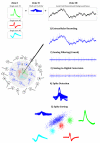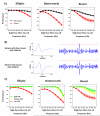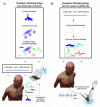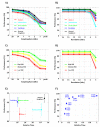Minimum requirements for accurate and efficient real-time on-chip spike sorting
- PMID: 24769170
- PMCID: PMC4151286
- DOI: 10.1016/j.jneumeth.2014.04.018
Minimum requirements for accurate and efficient real-time on-chip spike sorting
Abstract
Background: Extracellular recordings are performed by inserting electrodes in the brain, relaying the signals to external power-demanding devices, where spikes are detected and sorted in order to identify the firing activity of different putative neurons. A main caveat of these recordings is the necessity of wires passing through the scalp and skin in order to connect intracortical electrodes to external amplifiers. The aim of this paper is to evaluate the feasibility of an implantable platform (i.e., a chip) with the capability to wirelessly transmit the neural signals and perform real-time on-site spike sorting.
New method: We computationally modelled a two-stage implementation for online, robust, and efficient spike sorting. In the first stage, spikes are detected on-chip and streamed to an external computer where mean templates are created and sent back to the chip. In the second stage, spikes are sorted in real-time through template matching.
Results: We evaluated this procedure using realistic simulations of extracellular recordings and describe a set of specifications that optimise performance while keeping to a minimum the signal requirements and the complexity of the calculations.
Comparison with existing methods: A key bottleneck for the development of long-term BMIs is to find an inexpensive method for real-time spike sorting. Here, we simulated a solution to this problem that uses both offline and online processing of the data.
Conclusions: Hardware implementations of this method therefore enable low-power long-term wireless transmission of multiple site extracellular recordings, with application to wireless BMIs or closed-loop stimulation designs.
Keywords: BMIs; Extracellular recordings; On-chip; On-line; Real-time; Spike sorting; Template matching.
Copyright © 2014 Elsevier B.V. All rights reserved.
Figures








Similar articles
-
Computationally efficient fully-automatic online neural spike detection and sorting in presence of multi-unit activity for implantable circuits.Comput Methods Programs Biomed. 2019 Oct;179:104986. doi: 10.1016/j.cmpb.2019.104986. Epub 2019 Jul 15. Comput Methods Programs Biomed. 2019. PMID: 31443868
-
Frameworks for Efficient Brain-Computer Interfacing.IEEE Trans Biomed Circuits Syst. 2019 Dec;13(6):1714-1722. doi: 10.1109/TBCAS.2019.2947130. Epub 2019 Oct 14. IEEE Trans Biomed Circuits Syst. 2019. PMID: 31613780
-
Realistic simulation of extracellular recordings.J Neurosci Methods. 2009 Nov 15;184(2):285-93. doi: 10.1016/j.jneumeth.2009.08.017. Epub 2009 Aug 22. J Neurosci Methods. 2009. PMID: 19703490
-
Spike sorting algorithms and their efficient hardware implementation: a comprehensive survey.J Neural Eng. 2023 Apr 14;20(2). doi: 10.1088/1741-2552/acc7cc. J Neural Eng. 2023. PMID: 36972585 Review.
-
Recent progress in multi-electrode spike sorting methods.J Physiol Paris. 2016 Nov;110(4 Pt A):327-335. doi: 10.1016/j.jphysparis.2017.02.005. Epub 2017 Mar 2. J Physiol Paris. 2016. PMID: 28263793 Free PMC article. Review.
Cited by
-
Decoding Local Field Potentials for Neural Interfaces.IEEE Trans Neural Syst Rehabil Eng. 2017 Oct;25(10):1705-1714. doi: 10.1109/TNSRE.2016.2612001. Epub 2016 Nov 14. IEEE Trans Neural Syst Rehabil Eng. 2017. PMID: 28113942 Free PMC article. Review.
-
Past, present and future of spike sorting techniques.Brain Res Bull. 2015 Oct;119(Pt B):106-17. doi: 10.1016/j.brainresbull.2015.04.007. Epub 2015 Apr 27. Brain Res Bull. 2015. PMID: 25931392 Free PMC article. Review.
-
Low-Impedance 3D PEDOT:PSS Ultramicroelectrodes.Front Neurosci. 2020 May 19;14:405. doi: 10.3389/fnins.2020.00405. eCollection 2020. Front Neurosci. 2020. PMID: 32508562 Free PMC article.
-
Filter based phase distortions in extracellular spikes.PLoS One. 2017 Mar 30;12(3):e0174790. doi: 10.1371/journal.pone.0174790. eCollection 2017. PLoS One. 2017. PMID: 28358895 Free PMC article.
-
Low-latency single channel real-time neural spike sorting system based on template matching.PLoS One. 2019 Nov 22;14(11):e0225138. doi: 10.1371/journal.pone.0225138. eCollection 2019. PLoS One. 2019. PMID: 31756211 Free PMC article.
References
-
- Abu-Nimeh FT, Aghagolzadeh M, Oweiss K. Real-time, on-chip spike sorting and firing rate estimation for cortically-controlled brain machine interface applications. 2009:39.
-
- Aghagolzadeh M, Oweiss K. An Adaptive Wireless Communication Protocol for Neural Data Transmission in Freely Behaving Subjects. 2011:404–7.
-
- Aghagolzadeh M, Zhang F, Oweiss K. An implantable VLSI architecture for real time spike sorting in cortically controlled Brain Machine Interfaces. Conf Proc IEEE Eng Med Biol Soc. 2010;2010:1569–1572. - PubMed
-
- Blatt M, Wiseman S, Domany E. Superparamagnetic clustering of data. Phys.Rev.Lett. 1996;76:3251–4. - PubMed
-
- Buzsaki G. Large-scale recording of neuronal ensembles. Nat.Neurosci. 2004;7:446–51. - PubMed
Publication types
MeSH terms
Grants and funding
LinkOut - more resources
Full Text Sources
Other Literature Sources

